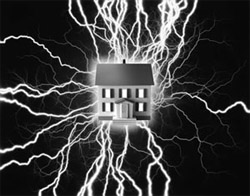
The Series Mode Alternative
Series Mode surge suppressors act first as low pass filters which simply block the high-frequency (HF) components of powerline surges.
The remaining low-frequency (LF) surge energy is diverted into a bank of capacitors where it is stored for the duration of the event and then slowly discharged back across the incoming hot and neutral conductors without involving any connection to Equipment Ground.
Series Mode surge suppressors can thus be placed anywhere along a power circuit without the ground reference elevation disadvantage of Shunt Mode surge protection devices.
Series Mode surge suppressors incorporate “floating clamping voltage” circuitry which will withstand considerable overvoltage conditions of indefinite duration without damage or degradation of performance, and are UL certified to a Surge Endurance specification of A-1-1, the highest possible rating available2.
Most importantly, Series Mode surge suppressors do not incorporate sacrificial components of any kind, effectively guaranteeing an unlimited service life without the requirement for testing and/or periodic maintenance.
Bottom Line
During a surge event, Shunt Mode surge suppressors located at the equipment load end of a branch circuit will cause an increase of local ground reference potential regardless of manufacturer and/or price.
Without periodic testing there is no guarantee of long-term protection due to the sacrificial nature of key components used in these devices.
Series Mode surge suppressors do not require periodic maintenance or testing, and do not cause an elevation of the local Equipment Ground reference potential during surge events regardless of where they are installed in an electrical power system. This is truly a quantum leap in real power line surge protection!
References
1. N. A. Muncy, Noise Susceptibility in Analog and Digital Signal Processing Systems, J. Audio Eng. Soc., Vol. 43, No. 6, 1995 June
2. The UL A-1-1 Surge Endurance testing procedure involves the application of a minimum of 1000 surges of 6,000 Volts at 3,000 Amperes (the highest surge voltages and currents likely to be encountered in a typical building), as specified in IEEE/ANSI C62.41-1991.
